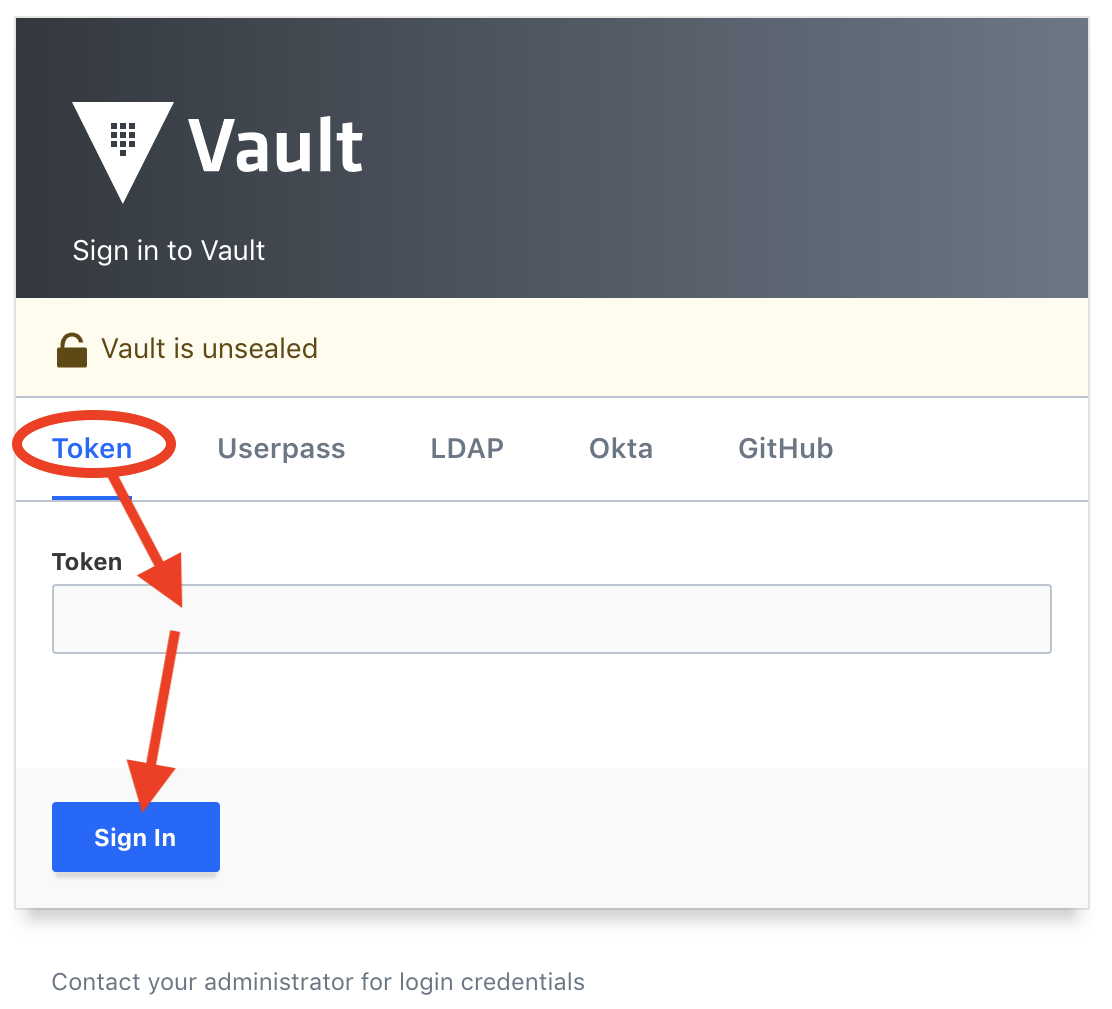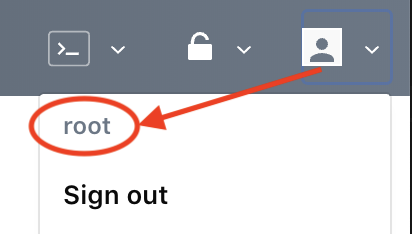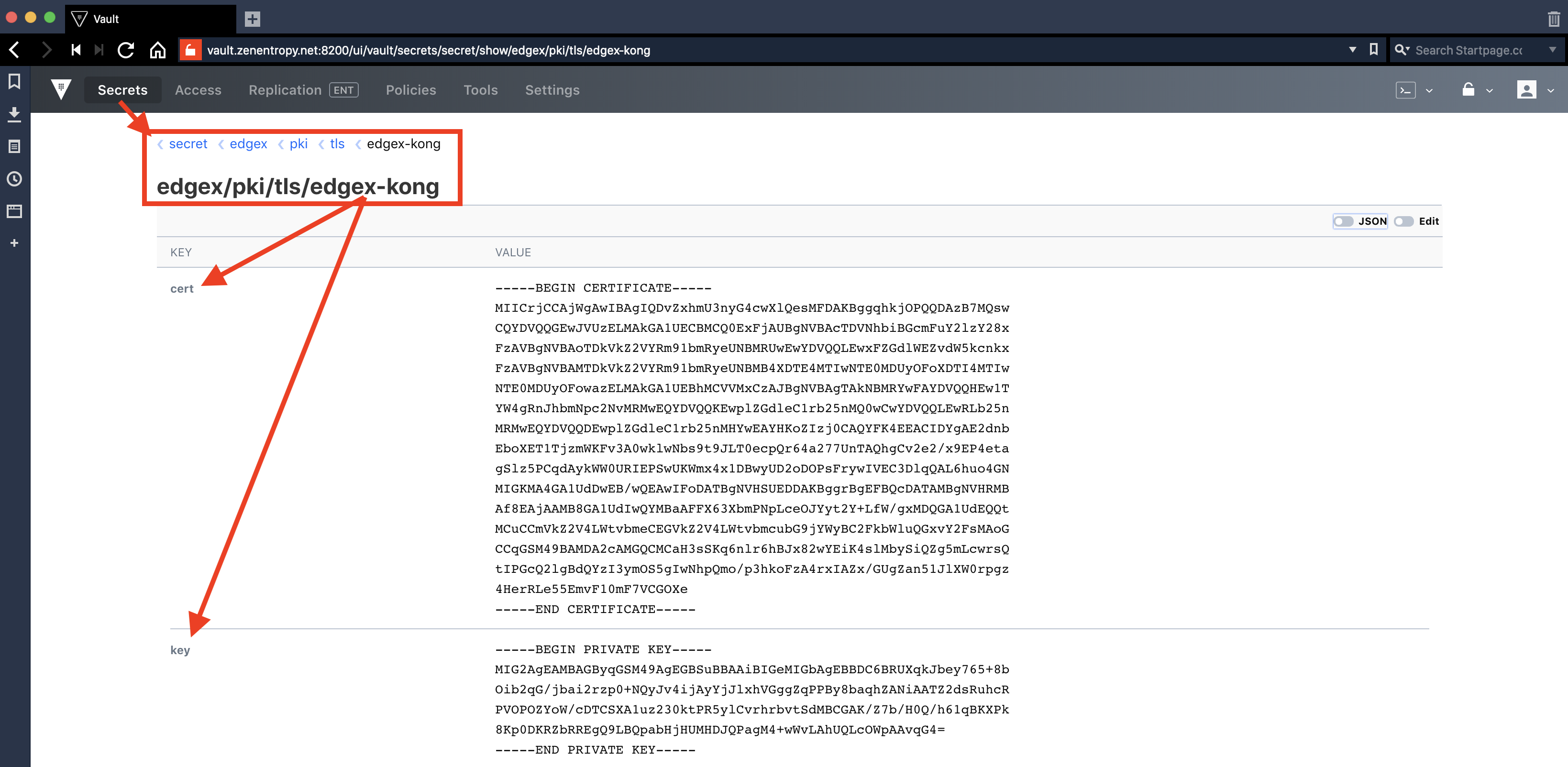Secret Store
Introduction
There are all kinds of secrets used within EdgeX Foundry micro services, such as tokens, passwords, certificates etc. The secret store serves as the central repository to keep these secrets. The developers of other EdgeX Foundry micro services utilize the secret store to create, store and retrieve secrets relevant to their corresponding micro services.
Currently the EdgeX Foundry secret store is implemented with Vault, a HashiCorp open source software product.
Vault is a tool for securely accessing secrets. A secret is anything that you want to tightly control access to, such as API keys, passwords, database credentials, service credentials, or certificates. Vault provides a unified interface to any secret, while providing tight access control and multiple authentication mechanisms (token, LDAP, etc.). Additionally, Vault supports pluggable "secrets engines". EdgeX uses the Consul secrets engine to allow Vault to issue Consul access tokens to EdgeX microservices.
In EdgeX, Vault's storage backend is the host file system.
Start the Secret Store
The EdgeX secret store is started by default when using the secure version of the Docker Compose scripts found at https://github.com/edgexfoundry/edgex-compose/tree/ireland.
The command to start EdgeX with the secret store enabled is:
git clone -b ireland https://github.com/edgexfoundry/edgex-compose
make run
or
git clone -b ireland https://github.com/edgexfoundry/edgex-compose
make run arm64
The EdgeX secret store is not started if EdgeX is started with security
features disabled by appending no-secty to the previous commands.
This disables all EdgeX security features, not just the API gateway.
Documentation on how the EdgeX security store is sequenced with respect to all of the other EdgeX services is covered in the Secure Bootstrapping of EdgeX Architecture Decision Record(ADR).
Using the Secret Store
Preferred Approach
The preferred approach for interacting with the EdgeX secret store is to use the
SecretClient interface in go-mod-secrets.
Each EdgeX microservice has access to a StoreSecrets() method that allows
setting of per-microservice secrets, and a GetSecrets() method to read them back.
If manual "super-user" to the EdgeX secret store is required, it is necesary to obtain a privileged access token, called the Vault root token.
Obtaining the Vault Root Token
For security reasons (the Vault production hardening guide recommends revokation of the root token), the Vault root token is revoked by default. EdgeX automatically manages the secrets required by the framework, and provides a programmatic interface for individual microservices to interact with their partition of the secret store.
If global access to the secret store is required, it is necessary to obtain a copy of the Vault root token using the below recommended procedure. Note that following this procedure directly contradicts the Vault production hardening guide. Since the root token cannot be un-revoked, the framework must be started for the first time with root token revokation disabled.
-
Shut down the entire framework and remove the Docker persistent volumes using
make cleaninedgex-composeordocker volume pruneafter stopping all the containers. Optionally remove/tmp/edgexas well to clean the shared secrets volume. -
Edit
docker-compose.ymland add an environment variable override forSECRETSTORE_REVOKEROOTTOKENS
secretstore-setup:
environment:
SECRETSTORE_REVOKEROOTTOKENS: "false"
-
Start EdgeX using
make runor some other mechanism. -
Reveal the contents of the
resp-init.jsonfile stored in a Docker volume.
docker run --rm -ti -v edgex_vault-config:/vault/config:ro alpine:latest cat /vault/config/assets/resp-init.json
- Extract the
root_tokenfield value from the resulting JSON output.
As an alternative to overriding SECRETSTORE_REVOKEROOTTOKENS from the beginning,
it is possible to regenerate the root token from the Vault unseal keys
in resp-init.json
using the Vault's documented procedure.
The EdgeX framework executes this process internally whenever it requires root token capability.
Note that a token created in this manner will again be revoked the next time EdgeX is restarted
if SECRETSTORE_REVOKEROOTTOKENS remains set to its default value: all root tokens
are revoked every time the framework is started if SECRETSTORE_REVOKEROOTTOKENS is true.
Using the Vault CLI
Execute a shell session in the running Vault container:
docker exec -it edgex-vault sh -l
Login to Vault using Vault CLI and the gathered Root Token:
edgex-vault:/# vault login s.ULr5bcjwy8S0I5g3h4xZ5uWa
Success! You are now authenticated. The token information displayed below
is already stored in the token helper. You do NOT need to run "vault login"
again. Future Vault requests will automatically use this token.
Key Value
--- -----
token s.ULr5bcjwy8S0I5g3h4xZ5uWa
token_accessor Kv5FUhT2XgN2lLu8XbVxJI0o
token_duration ∞
token_renewable false
token_policies ["root"]
identity_policies []
policies ["root"]
Perform an introspection lookup on the current token login.
This proves the token works and is valid.
edgex-vault:/# vault token lookup
Key Value
--- -----
accessor Kv5FUhT2XgN2lLu8XbVxJI0o
creation_time 1623371879
creation_ttl 0s
display_name root
entity_id n/a
expire_time <nil>
explicit_max_ttl 0s
id s.ULr5bcjwy8S0I5g3h4xZ5uWa
meta <nil>
num_uses 0
orphan true
path auth/token/root
policies [root]
ttl 0s
type service
!!! Note: The Root Token is the only token that has no expiration enforcement rules (Time to Live TTL counter).
As an example, let's poke around and spy on the Redis database password:
edgex-vault:/# vault list secret
Keys
----
edgex/
edgex-vault:/# vault list secret/edgex
Keys
----
app-rules-engine/
core-command/
core-data/
core-metadata/
device-rest/
device-virtual/
security-bootstrapper-redis/
support-notifications/
support-scheduler/
edgex-vault:/# vault list secret/edgex/core-data
Keys
----
redisdb
edgex-vault:/# vault read secret/edgex/core-data/redisdb
Key Value
--- -----
refresh_interval 168h
password 9/crBba5mZqAfAH8d90m7RlZfd7N8yF2IVul89+GEaG3
username redis5
With the root token, it is possible to modify any Vault setting. See the Vault manual for available commands.
Use the Vault REST API
Vault also supports a REST API with functionality equivalent to the command line interface:
The equivalent of the
vault read secret/edgex/core-data/redisdb
command looks like the following using the REST API:
Displaying (GET) the redis credentials from Core Data's secret store:
curl -s -H 'X-Vault-Token: s.ULr5bcjwy8S0I5g3h4xZ5uWa' http://localhost:8200/v1/secret/edgex/core-data/redisdb | python -m json.tool
{
"request_id": "9d28ffe0-6b25-c0a8-e395-9fbc633f20cc",
"lease_id": "",
"renewable": false,
"lease_duration": 604800,
"data": {
"password": "9/crBba5mZqAfAH8d90m7RlZfd7N8yF2IVul89+GEaG3",
"username": "redis5"
},
"wrap_info": null,
"warnings": null,
"auth": null
}
See HashiCorp Vault API documentation for further details on syntax and usage (https://www.vaultproject.io/api/).
Using the Vault Web UI
The Vault Web UI is not exposed via the API gateway.
It must therefore be accessed via localhost or a network tunnel of some kind.
Open a browser session on http://localhost:8200
and sign-in with the Root Token.
 {.align-center width="606px"
height="504px"}
{.align-center width="606px"
height="504px"}
Upper left corner of the current Vault UI session, the sign-out menu displaying the current token name:
 {.align-center width="275px"
height="156px"}
{.align-center width="275px"
height="156px"}
Select the Vault secret backend:

Navigate the API Gateway (Kong) service X.509 TLS materials path (edgex/pki/tls/edgex-kong):

The Vault UI also allows entering Vault CLI commands (see above 1st alternative) using an embedded console:

See also
Some of the command used in implementing security services have man-style documentation:
- security-file-token-provider - Generate Vault tokens for EdgeX services
- secrets-config - Utility for secrets management.
- secrets-config-proxy - "proxy" subcommand for managing proxy secrets.